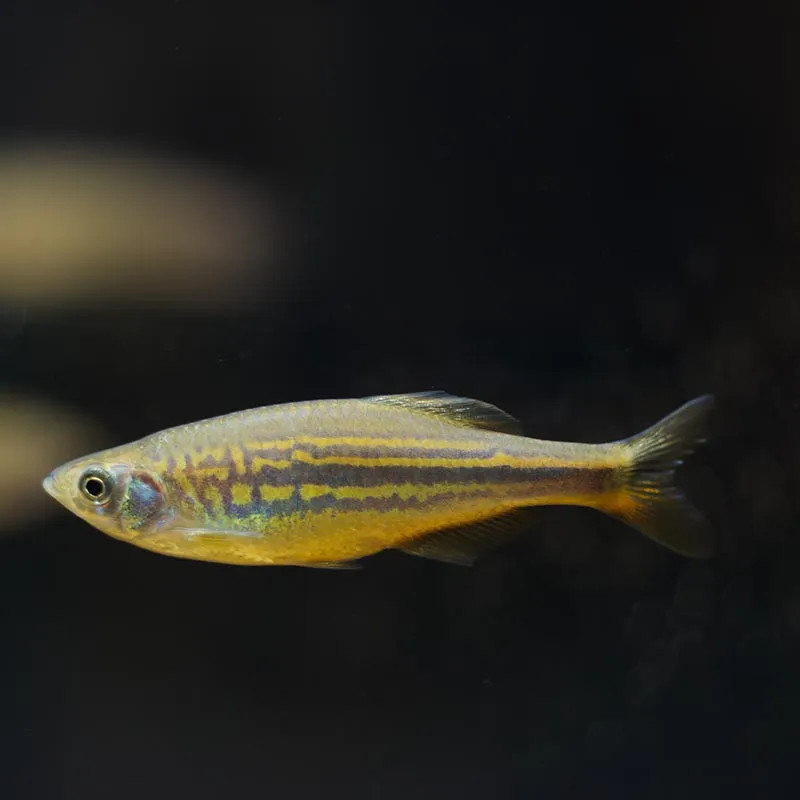Stocks Available
White Cloud Mountain Minnow
SKU:121346
GYMNOCORYMBUS TERNETZI
0.79 INCH

Stock Available
Introduction: Species: Devario aequipinnatus Common Names: Giant Danio, Giant Zebra Danio Natural Habitat: Native to freshwater rivers and streams in Southeast Asia, particularly in the countries of India, Bangladesh, and Myanmar, the Giant Danio is typically found in shallow, fast-flowing waters with abundant vegetation. Physical Characteristics: Appearance: The Giant Danio is characterized by its elongated, streamlined body and vibrant coloration. It displays striking horizontal blue and silver stripes along its body, complemented by a yellowish or greenish hue. The fins are generally clear but may have a slight tint. Size: Grows to about 4-6 inches (10-15 cm) in length. Lifespan: Typically lives for 4-6 years with proper care. Habitat Requirements: Tank Size: A minimum of 20 gallons is recommended for a small group; larger tanks are preferred to provide adequate swimming space. Water Conditions: Temperature: 72-78°F (22-26°C). pH: 6.5-7.5 (neutral to slightly acidic). Hardness: Soft to moderately hard water (5-15 dGH). Aquascaping: Provide a well-planted aquarium with open swimming areas and some hiding spots using live plants, rocks, and driftwood to mimic their natural environment. Diet: Primary Diet: Omnivorous; in the wild, they feed on a variety of small insects, zooplankton, and plant matter. Supplemental Feeding: In captivity, offer high-quality flakes or pellets, supplemented with live or frozen foods like daphnia, brine shrimp, and bloodworms. Feeding Frequency: Feed small portions 1-2 times a day for optimal health, ensuring that any uneaten food is promptly removed to maintain water quality. Compatibility: Temperament: Generally peaceful and social; best kept in groups of 6 or more to promote natural schooling behavior. Suitable Tank Mates: Compatible with other small, peaceful community fish like Tetras, Guppies, Rasboras, and other Danios. Incompatibilities: Avoid aggressive or larger species that may stress or harm the Giant Danios. Care Level: Difficulty: Easy; they are hardy and adaptable, making them ideal for beginner aquarists. Health Monitoring: Monitor for signs of disease, especially stress-related issues and common parasites. Regular water changes and good filtration are essential for their overall health. Breeding: Breeding in Captivity: Breeding is relatively straightforward and can be done in a separate breeding tank. Spawning: They are egg scatterers and lay their eggs among fine-leaved plants. After spawning, the parents should be removed to prevent them from eating the eggs. Economic Considerations: Market Demand: The Giant Danio is popular among freshwater aquarium enthusiasts due to its size, vibrant colors, and active nature. Wholesale/Retail Pricing: Prices can vary, but they are generally affordable, making them accessible for many aquarists. Sustainability and Conservation: Wild Population: While not currently endangered, habitat degradation can affect natural populations. Aquaculture Efforts: Often bred in captivity to meet market demand and reduce reliance on wild populations. Regulations: Compliance with local and international regulations regarding the trade of freshwater fish is essential for conservation. Conclusion: The Giant Danio is a colorful and energetic addition to freshwater aquariums, valued for its striking appearance and sociable behavior. Their care requirements and ease of breeding make them suitable for both novice and experienced aquarists. With proper attention to their habitat and dietary needs, Giant Danios can thrive, contributing vibrancy and activity to any aquarium setting.
Data sheet
16 other products in the same category:
Customers who bought this product also bought: